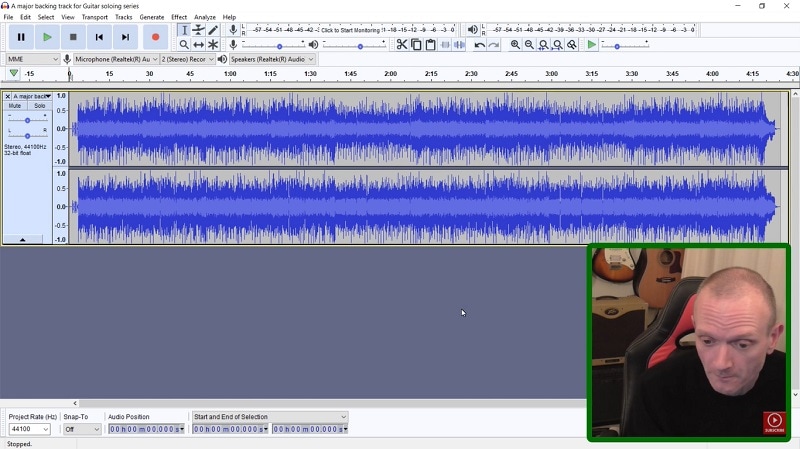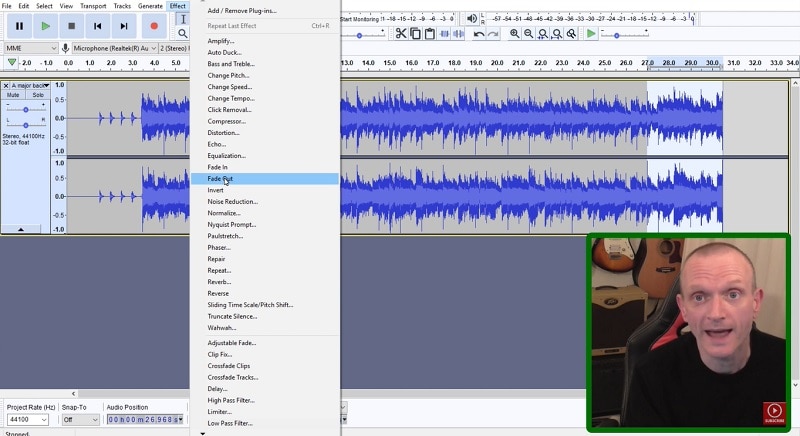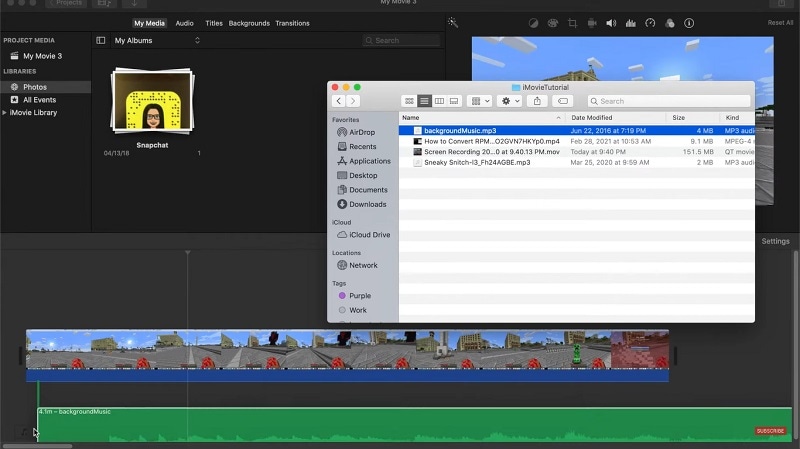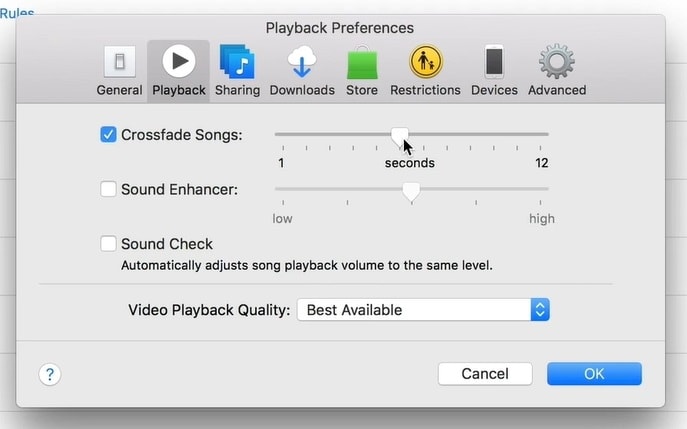:max_bytes(150000):strip_icc()/AirTags-d0c59672dec24b1b947c239fd7c6b934.jpg)
Reducing Volume Stealthily on Computers (OS X & Windows) for 2024

Reducing Volume Stealthily on Computers (OS X & Windows)
Musicians all around the world keep on searching for music in every little thing in the world. Thus, they have a professional sense of judging and creating music to implement new ideas, music decors, autotunes, and fade-in and fade-out concepts. In case you do not know what music Fade in and fade out is, then for your information, these are sound effects where the Fade in-music effect is usually used at the beginning of the song.
It begins from absolute silence to smooth melody; the music fade-out effect is generally implemented at the end of the song which slowly goes silent from the melodious tune.
Why Do People Use Fade In/Out Effects?
Now you might be confused about why musicians use such Fade in and out effects in their songs. The reason is relatively easy to understand; music does not always have any particular source or motive. Thus, it might appear abruptly in your head, out of nowhere. Shaping it and tuning it in the right way is the work of a musician.
However, it sometimes happens that the professionally composed music might not sound great due to such abrupt endings or starting. This is when such musical effects come to the rescue.
Part 1. How to Fade Music on Windows PC
The term fades in and fades out music effect might sound very professional and out of reach of most struggling musicians. However, it is not the same. Anybody with a proficient sense of music and a pair of ears to judge whether the tune sounds soothing or not can easily use these musical effects on their systems. If you have a Windows PC at your place, it might be handy for adding the Fade in and out effect to your songs.
Way 1 - Fade music on PC with Filmora
If you are looking for applications to edit your audio file most professionally, the Filmora might be the right option. It has vibrant music effects, ease of use functions, accessible interfaces, etc. The way in which Filmora enacts everything is so easy that even a new user of the application would not face many problems in adding Fade out music options at once. If you are yet confused about how to add such suitable effects to your audio files, then the following steps might be of great help to you:
Free Download For Win 7 or later(64-bit)
Free Download For macOS 10.14 or later
- You can search for the location of the audio file from your system and import it to Filmora for the edits.

- In the next step, you must click on the audio file and go to the animation tab to find the preset button.
- Upon expanding the options, you could find fade music options in different types.
- At last, you must choose a particular fading effect and drag the slider on the audio file to adjust the fade music effect accordingly.

Way 2 - Use Audacity to Fade Audio
Yet another fantastic option for adding fade music effects on the audio files is none other than using Audacity. It is a similar music editing application that almost everyone can use according to their convenience. Such apps entirely depend on what piece and purpose you want to utilize. If you are a PC user and want to utilize Audacity facilities, then the following steps might be helpful to you:
- Select or highlight the audio file you want to edit.

- Go to the effect menu and spot the Fade in or fade-out option.

- Use the effects by dragging the slider on the audio file to get the desired fade music result.
Part 2. How to Fade in/out Music on Mac
Just like the Windows PC users, MAC users can quickly opt for fading in and fading out music effects. Some people consider everything about MAC expensive as most things do not come for free. However, while adding fade music effects from your MAC, you would not face any problems as popular platforms like iMovie and Music Apple can help you carry out the task professionally and free of cost.
Way 1 - Use iMovie to Fade audio on Mac
iMovie is the official platform that 90% of MAC users use to edit audio files and music books in the best way possible. This application is indeed highly compatible with the MAC’s system. Thus, it would not be challenging for you to figure out the necessary buttons on iMovie at once. Here are the steps:
- iMovie enables its users to edit certain portions of the audio files. Thus, you can choose the part by dragging the slider you want to edit.

- Once upon choosing the portion, you will notice the fade handles. Drag the handles to the beginning for Fade in effect and the opposite in the other end.

Way 2 - Use Apple Music App to Fade Audio
One of the best apps for Apple MAC users for editing soundtracks is none other than the Apple Music app. This app comes for free tools until and unless you want some special effects. The easy-to-use interface helps even the newbie music editors to find their way through the musical folds of music in the easiest route. However, you can check out the following points for a better understanding of this app:
- After opening the app, you must click on the hamburger sign or the three dots in the upper right-hand corner.
- The settings page would let you add the necessary audio file from your device to the editing platform at once.
- You can enable the crossfade option from the menu box in the settings.

- It would lead you to another page on Apple music where you can enable the automatic option for the app to edit the file by adding fade music effects, or you can manually do it all by yourself.
Part 3. How to Fade Music Online
If you think you would have to take the help of any of the above platforms to get your desired Fade in and fade-out effect on the soundtracks, then you are under a misconception. Cleo is one of the online platforms which you can directly use from your browser to fade out music online. However, it might confuse the rookie users in the initial stages; with each passing day, they would be able to work on the suitable outcomes from video in no time. The following steps might come in handy:
- You need to add the song to the Clideo platform by uploading it from your dropbox or drive. You can also directly cut it from the above locations.
- Select a particular portion you want to edit in the soundtrack and look for the Fade in and fade-out options from the bottom boxes.
- After applying the fade music effect to the audio file, you can easily export it in your suitable format. Options are given below.
- Save the file in the next step.
Adding fade music effects is not only about making money or trying to add spine to any average soundtrack. It is about stopping the abrupt ending or initiating a song with complete meaning and a soothing effect on the ears. Fading music is mainly focused on correcting the soundtrack so that the soothing effect remains intact throughout the time. The above article might be helpful to you with all the adequate info now.
- Way 1 - Use iMovie to Fade audio on Mac
- Way 2 - Use Apple Music App to Fade Audio
- How to Fade Music Online
The term fades in and fades out music effect might sound very professional and out of reach of most struggling musicians. However, it is not the same. Anybody with a proficient sense of music and a pair of ears to judge whether the tune sounds soothing or not can easily use these musical effects on their systems. If you have a Windows PC at your place, it might be handy for adding the Fade in and out effect to your songs.
Way 1 - Fade music on PC with Filmora
If you are looking for applications to edit your audio file most professionally, the Filmora might be the right option. It has vibrant music effects, ease of use functions, accessible interfaces, etc. The way in which Filmora enacts everything is so easy that even a new user of the application would not face many problems in adding Fade out music options at once. If you are yet confused about how to add such suitable effects to your audio files, then the following steps might be of great help to you:
Free Download For Win 7 or later(64-bit)
Free Download For macOS 10.14 or later
- You can search for the location of the audio file from your system and import it to Filmora for the edits.

- In the next step, you must click on the audio file and go to the animation tab to find the preset button.
- Upon expanding the options, you could find fade music options in different types.
- At last, you must choose a particular fading effect and drag the slider on the audio file to adjust the fade music effect accordingly.

Way 2 - Use Audacity to Fade Audio
Yet another fantastic option for adding fade music effects on the audio files is none other than using Audacity. It is a similar music editing application that almost everyone can use according to their convenience. Such apps entirely depend on what piece and purpose you want to utilize. If you are a PC user and want to utilize Audacity facilities, then the following steps might be helpful to you:
- Select or highlight the audio file you want to edit.

- Go to the effect menu and spot the Fade in or fade-out option.
- Use the effects by dragging the slider on the audio file to get the desired fade music result.
Part 2. How to Fade in/out Music on Mac
Just like the Windows PC users, MAC users can quickly opt for fading in and fading out music effects. Some people consider everything about MAC expensive as most things do not come for free. However, while adding fade music effects from your MAC, you would not face any problems as popular platforms like iMovie and Music Apple can help you carry out the task professionally and free of cost.
Way 1 - Use iMovie to Fade audio on Mac
iMovie is the official platform that 90% of MAC users use to edit audio files and music books in the best way possible. This application is indeed highly compatible with the MAC’s system. Thus, it would not be challenging for you to figure out the necessary buttons on iMovie at once. Here are the steps:
- iMovie enables its users to edit certain portions of the audio files. Thus, you can choose the part by dragging the slider you want to edit.
 Nero Burning ROM:
Nero Burning ROM:
The ultimate burning program for all your needs!

- Once upon choosing the portion, you will notice the fade handles. Drag the handles to the beginning for Fade in effect and the opposite in the other end.

Way 2 - Use Apple Music App to Fade Audio
One of the best apps for Apple MAC users for editing soundtracks is none other than the Apple Music app. This app comes for free tools until and unless you want some special effects. The easy-to-use interface helps even the newbie music editors to find their way through the musical folds of music in the easiest route. However, you can check out the following points for a better understanding of this app:
- After opening the app, you must click on the hamburger sign or the three dots in the upper right-hand corner.
- The settings page would let you add the necessary audio file from your device to the editing platform at once.
- You can enable the crossfade option from the menu box in the settings.

- It would lead you to another page on Apple music where you can enable the automatic option for the app to edit the file by adding fade music effects, or you can manually do it all by yourself.
Part 3. How to Fade Music Online
If you think you would have to take the help of any of the above platforms to get your desired Fade in and fade-out effect on the soundtracks, then you are under a misconception. Cleo is one of the online platforms which you can directly use from your browser to fade out music online. However, it might confuse the rookie users in the initial stages; with each passing day, they would be able to work on the suitable outcomes from video in no time. The following steps might come in handy:
- You need to add the song to the Clideo platform by uploading it from your dropbox or drive. You can also directly cut it from the above locations.
- Select a particular portion you want to edit in the soundtrack and look for the Fade in and fade-out options from the bottom boxes.
- After applying the fade music effect to the audio file, you can easily export it in your suitable format. Options are given below.
- Save the file in the next step.
Adding fade music effects is not only about making money or trying to add spine to any average soundtrack. It is about stopping the abrupt ending or initiating a song with complete meaning and a soothing effect on the ears. Fading music is mainly focused on correcting the soundtrack so that the soothing effect remains intact throughout the time. The above article might be helpful to you with all the adequate info now.
- Title: Reducing Volume Stealthily on Computers (OS X & Windows) for 2024
- Author: Richard
- Created at : 2024-07-30 02:40:11
- Updated at : 2024-07-31 02:40:11
- Link: https://extra-support.techidaily.com/reducing-volume-stealthily-on-computers-os-x-and-windows-for-2024/
- License: This work is licensed under CC BY-NC-SA 4.0.

 The BootIt Collection covers multi-booting, partitioning, and disk imaging on traditional PC’s using the standard BIOS and newer PC’s using UEFI. The collection includes BootIt Bare Metal (BIBM) for standard BIOS systems and BootIt UEFI (BIU) for UEFI system.
The BootIt Collection covers multi-booting, partitioning, and disk imaging on traditional PC’s using the standard BIOS and newer PC’s using UEFI. The collection includes BootIt Bare Metal (BIBM) for standard BIOS systems and BootIt UEFI (BIU) for UEFI system.

 EaseText Audio to Text Converter for Windows (Personal Edition) - An intelligent tool to transcribe & convert audio to text freely
EaseText Audio to Text Converter for Windows (Personal Edition) - An intelligent tool to transcribe & convert audio to text freely